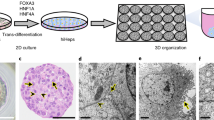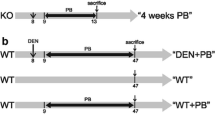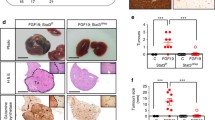Abstract.
The mouse strain C3H shows high incidence of liver tumors in carcinogenicity testing, while the strain C57BL exhibits low incidence. The F1 generation hybrids, B6C3F1, which are widely used in long-term carcinogenesis bioassays, are of intermediate sensitivity. We asked whether this strain difference could be due to different susceptibility of the parenchymal cells to signals inducing replication or apoptosis. Hepatocytes were isolated and cultured according to standard protocols. We tested (1) for the induction of DNA synthesis by epidermal growth factor (EGF), (2) for its inhibition by TGF-β1, and (3) for the induction of apoptosis by TGF-β1. Basal rates of DNA synthesis in untreated hepatocytes cultured from C3H and B6C3F1 mice were 6.5 and 3.5 times higher, respectively, than in hepatocytes from C57BL on day 3. Moreover, addition of EGF (10 ng/ml) increased DNA synthesis on day 3 in hepatocytes from C3H (4.2-fold) and B6C3F1 (2.7-fold) more strongly than in hepatocytes from C57BL. Treatment with TGF-β1 inhibited basal and EGF-stimulated DNA synthesis dose-dependently. Inhibition was maximal at 1 ng TGF-β1/ml in cultures from C57BL mice, and at 0.3 ng/ml in hepatocytes from C3H mice. In untreated hepatocytes from both strains virtually no apoptotic figures (condensed or fragmented nuclei, Hoechst 33285 staining) were found. After treatment with TGF-β1 the incidence of apoptotic nuclei in hepatocytes from C57BL was higher than in cells from C3H mice (1.7% vs 3% on day 3). Thus it appears that hepatocytes from C57BL mice possess a lower growth potential, as indicated by a low basal rate of DNA synthesis and low inducibility by EGF, but a higher sensitivity to induction of apoptosis by TGF-β1 than hepatocytes of the C3H strain. These findings may be helpful to explain the different susceptibility to induction of hepatocarcinogenesis in C3H and C57BL mice.
Similar content being viewed by others
Author information
Authors and Affiliations
Additional information
Electronic Publication
Rights and permissions
About this article
Cite this article
Parzefall, W., Kainzbauer, E., Qin, HM. et al. Response of isolated hepatocytes from carcinogen sensitive (C3H) and insensitive (C57BL) mice to signals inducing replication or apoptosis. Arch Toxicol 76, 699–706 (2002). https://doi.org/10.1007/s00204-002-0397-8
Received:
Accepted:
Issue Date:
DOI: https://doi.org/10.1007/s00204-002-0397-8




